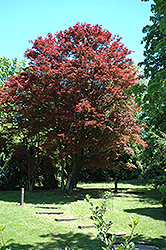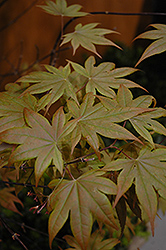Red-Leaf Japanese Maple
Acer palmatum 'Atropurpureum'
Height: 6 feet
Spread: 5 feet
Sunlight:
![]()
![]()
Hardiness Zone: (annual)
Description:
One of the most stunning landscape accent trees available, featuring an incredibly artistic habit of growth and distinctively palm-shaped leaves that emerge rich purple and darken to a deep green-bronze over summer.
Ornamental Features
Red-Leaf Japanese Maple is primarily valued in the landscape or garden for its ornamental globe-shaped form. It features subtle corymbs of red flowers rising above the foliage in mid spring before the leaves. Its attractive lobed palmate leaves emerge deep purple in spring, turning dark green in colour with prominent deep purple tips. As an added bonus, the foliage turns a gorgeous red in the fall. The red stems can be quite attractive.
Landscape Attributes
Red-Leaf Japanese Maple is an open annual with a more or less rounded form. Its relatively fine texture sets it apart from other garden plants with less refined foliage.
This is a relatively low maintenance plant, and should only be pruned in summer after the leaves have fully developed, as it may 'bleed' sap if pruned in late winter or early spring. It has no significant negative characteristics.
Red-Leaf Japanese Maple is recommended for the following landscape applications;
- Topiary
- Container Planting
Planting & Growing
Red-Leaf Japanese Maple will grow to be about 6 feet tall at maturity, with a spread of 5 feet. Although it's not a true annual, this slow-growing plant can be expected to behave as an annual in our climate if left outdoors over the winter, usually needing replacement the following year. As such, gardeners should take into consideration that it will perform differently than it would in its native habitat.
This plant does best in full sun to partial shade. It prefers to grow in average to moist conditions, and shouldn't be allowed to dry out. It is not particular as to soil pH, but grows best in rich soils. It is somewhat tolerant of urban pollution. Consider applying a thick mulch around the root zone in winter to protect it in exposed locations or colder microclimates. This is a selected variety of a species not originally from North America.
Red-Leaf Japanese Maple is a fine choice for the yard, but it is also a good selection for planting in outdoor pots and containers. Because of its height, it is often used as a 'thriller' in the 'spiller-thriller-filler' container combination; plant it near the center of the pot, surrounded by smaller plants and those that spill over the edges. It is even sizeable enough that it can be grown alone in a suitable container. Note that when growing plants in outdoor containers and baskets, they may require more frequent waterings than they would in the yard or garden.

